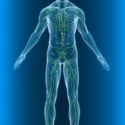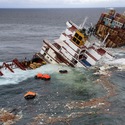In October 2011, the Greek container ship MV Rena ran aground on Ōtāiti, also known as the Astrolabe Reef, off the coast of Tauranga.
The oil spill resulted in the New Zealand’s worst maritime disaster in terms of environmental impact.
Initial efforts were concentrated on containing the oil spill to minimise the environmental impacts and minimising the pollution from the containers. Several years on, the impacts of this disaster are still being monitored and assessed.
Rena disaster
To better understand the extent of the Rena grounding on the Tauranga environment and the initial efforts to clean up the oil, diesel and container pollution, explore Where land meets sea.
Iwi1 and hapū2 played an important role from the outset of the disaster with the formation of the Ngā Iwi o Tauranga Moana group to represent local tangata whenua3 and the research group Te Mauri Moana to monitor kaimoana4. Read about these initiatives, in the article Iwi and kaimoana.
Te whāinga – the goal
In 2012, the Ministry for the Environment launched its Environmental Recovery Plan. Environmental law in New Zealand recognises the need to protect the ‘intrinsic values of the environment’ or the ‘mauri’.
Our involvement is to make sure, through getting recognition of mauri5, that Māori values are carried out in the assessment of the recovery of the environment … because if we don’t assert ourselves and our legitimate models … well we’re not doing justice to our kaitiakitanga6 to our tūpuna7.
Raewyn Bennett, Ngāti Makino, Ngāti Pikiao
Included in the Recovery Plan was the stated goal to restore the mauri of the area to its pre-Rena state.
What is mauri?
Mauri is an integral part of being Māori. Local Ngāti Makino and Ngāti Pikiao kuia8 Raewyn Bennett describes mauri as being about respect for the environment and “respect for life and for things the creators have made, our tūpuna, our gods, and we have to maintain that mauri because it’s an intrinsic part of being Māori.”
So can you go about measuring mauri in order to determine environmental impacts and solutions in situations like the Rena grounding?
The Mauri model
Dr Kepa Morgan had established a mauri model as part of his work at the Engineering School at Auckland University. This was because he had been interested in how to incorporate mauri into engineering decisions.
Engineering decisions are frequently driven by economics and money, and Dr Morgan realised that, in order to include Māori thinking, a model needed to be developed where mauri was the driver. Mauri as a driver allows for a more holistic9 approach that incorporates economic considerations – but not at the exclusion of Māori world views.
Prior to the Rena grounding, the model had been tested in relation to the Christchurch earthquakes and by iwi wanting to restore a marine ecosystem10 following the impacts of urban development.
Models for inclusion
Models are an important tool to ensure that Māori world views are incorporated into ecological decision making.
Waikato-Tainui researcher Lorraine Dixon of the Waahi Whaanui Trust helped to develop a model that allows larger numbers of iwi to participate in decision making using cultural indicators. These cultural indicators are important in assessing and restoring the health of the local Waikato River in the Huntly area. Read about this in the article Model for identifying cultural indicators.
Solution
Dr Kepa Morgan’s mauri model presents mauri as a continuum or range between different extremes. The negative extreme is “Mauri moe, mauri noho” where the mauri is exhausted. At the other end, “Mauri tu, mauri ora” is where the mauri is vibrant and it has its fullest potential to support life.
The model has been used in an ongoing series11 of workshops in the Bay of Plenty. The model has given local iwi a means to analyse the impacts of the Rena disaster recovery operation using a holistic response.
Project Mātauranga
Watch Series 2/Episode 12: The Rena Disaster
Project Mātauranga is a television series that investigates Māori world views and methodologies within the scientific community12 and looks at their practical application. Each of the 13 episodes in series 2 shows how western science and Māori knowledge systems are combining to provide solutions to a variety of challenges.
The Science Learning Hub thanks Scottie Productions for allowing us to host these videos.
Nature of science
Considering different world views, sharing knowledge and understandings to inform decisions is an integral part of investigating and communicating in science.
Related content
Science increasingly draws on the knowledge of local iwi. For stories about this, see these Connected articles Counting kākahi and Learning from the tangata whenua.
Activity idea
In this activity, Responding to Rena students consider short-term and long-term responses to an environmental disaster such as the Rena grounding and oil spill. The activity includes a role play that can be adapted to include the response of an iwi group using Dr Kepa Morgan’s mauri model.
Useful links
In July 2015, the Ministry for the Environment declared the Rena Recovery Programme was complete. Through this plan, iwi representatives worked alongside government agencies and research providers to deliver on a set of environmental and cultural restoration and research projects.
View information on oils spills and the Rena oils spills on the Bay of Plenty Regional Council website teacher resources section.
For more on the Rena disaster and the response by local iwi, see After the spill, Connected 2013, Level 4.
- iwi: Māori tribe or large community, often consisting of several hapū (clans) bound together by common ancestors.
- hapū: A division of a Māori tribe or iwi. Māori clans or subtribes.
- tangata whenua: A Māori term that literally means ‘people of the land’, used to refer to Māori as the indigenous people of New Zealand.
- kaimoana: Māori word for seafood.
- mauri: Life force or spiritual essence of a person, place or thing.
- kaitiakitanga: A Māori term that encompasses ideas about care and guardianship of the sea, sky and land – the environment. Kaitiaki refers to those who carry out kaitiakitanga such as tangata whenua (people of the land).
- tūpuna: Māori term for ancestors.
- kuia: Māori word for an elderly woman, grandmother or female elder.
- holistic: Emphasising the importance of the whole and the interdependence of its parts, looking at the entire system. In healthcare, this means looking at all aspects of a patient's well-being and not just treating a particular pain or disease.
- ecosystem: An interacting system including the biological, physical, and chemical relationships between a community of organisms and the environment they live in.
- series: An electrical circuit layout where components are connected one after the other so that the current passes in a single path through the components.
- scientific community: The total body of scientists, their relationships and interactions.













